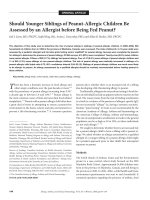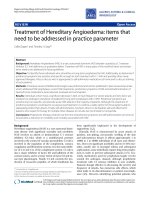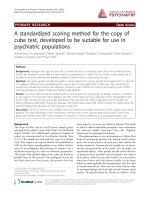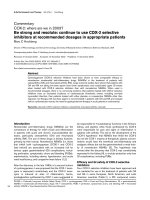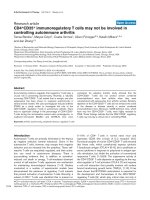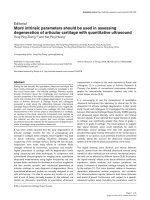Báo cáo y học: "Tracheostomy must be individualized" ppsx
Bạn đang xem bản rút gọn của tài liệu. Xem và tải ngay bản đầy đủ của tài liệu tại đây (37.6 KB, 3 trang )
322
ICU = intensive care unit.
Critical Care October 2004 Vol 8 No 5 Pelosi and Severgnini
Tracheostomy is among the most frequently conducted
procedures in critically ill patients [1]. It has advantages
compared with translaryngeal endotracheal intubation, including
reduced laryngeal anatomical alteration, reduced inspiratory
load, and better patient tolerance and ease of nursing. Thus,
tracheostomy can enhance patient care in the event of
prolonged respiratory support and difficulty in weaning.
In the study conducted by Arabi and colleagues [2], those
investigators examined the frequency with which
tracheostomy was conducted; pathophysiological
characteristics of patients undergoing early (first week in the
intensive care unit [ICU]) and late tracheostomy (> 7 days in
the ICU); and the impact of early tracheostomy on the
duration of mechanical ventilation, ICU length of stay and
outcomes in a selected population of trauma patients. They
reported that the majority of patients underwent
tracheostomy after the first week, and that patients who
received tracheostomy within the first week had maxillofacial
trauma and more severe neurological injuries. Multivariate
analysis showed that early tracheostomy was associated with
reduced ICU length of stay. That study presents several
issues that require consideration when interpreting the
findings. First, the data are from a single population of
patients with severe neurological and maxillofacial trauma.
Second, both surgical and percutaneous tracheostomy
techniques were performed. Finally, the percutaneous
techniques used in the study were not reported.
The optimal timing of tracheostomy remains controversial.
The results presented suggest that early tracheostomy may
reduce ICU length of stay and resource utilization in severe
Commentary
Tracheostomy must be individualized!
Paolo Pelosi and Paolo Severgnini
Universita’ degli Studi dell’Insubria, Servizio di Anestesia B, Ospedale di Circolo e Fondazione Macchi, Varese, Italy
Corresponding author: Paolo Pelosi,
Published online: 8 September 2004 Critical Care 2004, 8:322-324 (DOI 10.1186/cc2966)
This article is online at />© 2004 BioMed Central Ltd
Related to Research by Arabi et al., see page 395
Abstract
Tracheostomy is one of the most frequent procedures carried out in critically ill patients with major
advantages compared to translaryngeal endotracheal intubation such as reduced laryngeal anatomical
alterations, reduced inspiratory load, better patient's tolerance and nursing. Thus, tracheostomy can
enhance patient's care in patients who need prolonged mechanical ventilation and/or control of
airways. The right timing of tracheostomy remains controversial, however it appears that early
tracheostomy in selected severe trauma, burn and neurological patients could be effective to reduce
the duration of mechanical ventilation intensive care stay and costs. Percutaneous tracheostomy
techniques are becoming the procedure of choice in the majority of the cases, since they are safe,
easy and quick, and complications are minor. However, percutaneous tracheostomies should be
always performed by experienced physicians to avoid unnecessary additional complications. It is not
clear the superiority of one percutaneous technique compared to another, but experience of the
operator and clinical individual anatomical, physiopathological characteristics of the patient should be
always considered. We believe that the operator should have experience of at least one intrusive and
one extrusive percutaneous technique. The general "optimal" tracheostomy technique and timing do
not exist, but tracheostomy should be targeted on the patient's individual clinical characteristics.
Keywords neurological injury, open surgical tracheostomy, percutaneous dilational tracheostomy, respiratory
failure, tracheostomy, trauma
323
Available online />trauma, which is in accordance with previous data reported in
patients with acute respiratory failure [3], but early
tracheostomy did not reduce hospital length of stay or
mortality. A recent study [4], performed in medical intensive
care patients, showed that early percutaneous dilational
tracheostomy outweighted the risks of prolonged
translaryngeal intubation, leading to reduced mortality,
pneumonia, ICU stay and duration of mechanical ventilation
There is general agreement that tracheal intubation should be
the first approach, and only thereafter is evaluation for
possible tracheostomy necessary. In particular, it has been
recommended that translaryngeal intubation be done in those
patients whose anticipated need is up to 10 days, and that
tracheostomy be done if an artificial airway is likely to be
required for longer than 21 days [5]. Tracheostomy is
mandatory in severe maxillofacial or neck trauma, burns to the
head, neck and airways, and presence of altered swallowing
(in which case early tracheostomy is needed). On the other
hand, tracheostomy is indicated for prolonged respiratory
support and airway maintenance in order to prevent
complications of long-term translaryngeal intubation in
chronic myopathies or laryngeal cord paralysis (late
tracheostomy). Regardless, the decision on the timing of
tracheostomy should be made on an individual basis, taking
into account the patient’s age and prognosis. In the study
conducted by Arabi and colleagues [2], 30% of
tracheostomies were surgical. Surgical tracheostomy is
mandatory, particularly in the presence of anatomical or
pathological alterations to the neck.
The percutaneous dilatation technique was proposed by
Ciaglia and coworkers [6] in 1985, and since then other
methods have been proposed so that percutaneous
tracheostomy may be performed at the bedside, rather than
surgical tracheostomy in the operating theatre [7–10].
Various complications have been reported for percutaneous
techniques, including tracheal ring fracture or dislocation,
tracheal stenosis and obliteration above the tracheostoma,
emphysema or pneumothorax due to posterior tracheal wall
laceration, tracheo-oesophageal fistola, and acute fatal
haemorrhage [11]. Several studies have compared safety
and outcome with percutaneous tracheostomy versus those
with surgical tracheostomy, but lack of rigorous design
renders useful comparisons quite impossible. The majority of
prospective randomized trials reported that potential
advantages of percutaneous technique relative to surgical
tracheostomy include ease of performance, and lower
incidence of peristomal bleeding and postoperative infection,
which are associated with lower costs [12–14]. Among the
percutaneous techniques, the most popular are the modified
original Ciaglia technique (‘single step’ Blue Rhino) [7], the
guidewire dilator forceps technique proposed by Griggs and
coworkers [8], the Percu-twist technique proposed by Frova
and Quintel [9], and the translaryngeal technique proposed
by Fantoni and Ripamonti [10].
The Blue Rhino, the Griggs and the Percu-twist techniques
are characterized by dilation of the tissues using forces
applied from outside to inside the tracheal wall (intrusive
techniques). The main potential complications with these
techniques are rupture or dislocation of tracheal rings and
bleeding. The main advantages are that ventilation is relatively
easy during the manoeuvre and the neck does not need to be
overdistended.
The translaryngeal technique is different from the others
becouse the cannula is stripped from inside to outside
(extrusive technique). This should reduce injury to the
anterior–posterior tracheal wall and bleeding. Thus, the
translaryngeal technique is indicated in patients with active
spontaneous bleeding or in patients at high risk for bleeding,
such as those receiving heparin therapy or with coagulation
factor deficits. Moreover, this technique is first choice in
paediatric patients, in whom other techniques are
contraindicated. The main problem with this technique is its
complexity because of the need for two intubations. Thus, the
technique is contraindicated in patients with expected
difficult intubation and in those in whom extension of the
neck must be avoided. Regardless of technique, it has been
suggested that bronchoscopy should be used when
performing percutaneous tracheostomy, with simple or video-
assisted endoscopy, to facilitate and reduce possible
complications [15]. Few studies in small groups of patients
have been performed, and so there are few data with which
to compare different percutaneous techniques [16–18]. In
general, it does not appear that any one percutaneous
technique is better than any other, but the patient’s choice
and the experience of the operator are determining factors.
It is important to emphasize that the introduction of different
percutaneous techniques has reduced the number of
supposed contraindications to tracheostomy in selected
patients. In cardiothoracic patients, with mediastinal wounds,
the percutaneous techniques should be considered first
choice because of the marked reduction in tracheostomy-
associated risk for mediastinitis. Tracheostomy in these
patients has also been reported to be effective in reducing
the duration of mechanical ventilation and in expediting
weaning [19]. In head trauma and neurological patients, who
are at high risk for nosocomial infection, the percutaneous
tracheostomy was found to be associated with a marked
reduction in late infections of the stoma. In severe head injury
patients, however, careful monitoring of the physiology of the
brain should be done, adequate sedation given, and timing
carefully considered. Tracheostomy should be performed as
soon as a stable physiological condition in the brain is
achieved and prolonged ventilation is expected [20].
However, in spine injured patients we believe that Blue
Rhino, Griggs and Percu-twist techniques are preferable
because of the reduced need to extend the neck to optimize
the manoeuvre. In patients with coagulation problems,
percutaneous techniques, and in particular the translaryngeal
324
Critical Care October 2004 Vol 8 No 5 Pelosi and Severgnini
technique, are indicated [21]. In patients with severe
respiratory failure percutaneous techniques have been found
to be safe, but it is wise to perform tracheostomy only when
respiratory insufficiency is stabilized [22]. Development of the
Griggs technique has broadened the indications for
tracheostomy to include emergency settings [23], whereas
the translaryngeal technique is contraindicated.
It is also important to emphasize that, after the procedure has
been completed, careful clinical monitoring of the patient is
mandatory, as well as bronchoscopy to clear airway
secretions and blood, and to confirm correct positioning of
the tracheostomic tube and so avoid bronchial intubation.
In conclusion, tracheostomy can offer several advantages in
the management of critically ill patients who need mechanical
ventilation and/or airway control. The optimal timing of
tracheostomy remains controversial, but it appears that early
tracheostomy in selected patients, such as those with severe
trauma, burns and neurological injuries, may be effective in
reducing the duration of mechanical ventilation, ICU stay and
costs. Percutaneous tracheostomy techniques are becoming
the procedures of choice in the majority of cases because
they are safe, easy and quick, and complications are minor.
However, percutaneous tracheostomies should always be
performed by experienced physicians so that unnecessary
additional complications may be avoided. It is not clear
whether any one percutaneous technique is superior to any
other, but experience of the operator and the anatomical and
physiopathological characteristics of the patient should
always be considered. The operator should have experience
of at least one intrusive and one extrusive percutaneous
technique. In general, the ‘optimal’ tracheostomy does not
exist; we must use the right technique in the right patient and
at the right time.
Competing interests
The authors declare that they have no competing interests.
References
1. Zetouni A, Kost K: Tracheostomy: a retrospective review of 281
cases. J Otolaryngol 1994, 23:61-66.
2. Arabi Y, Haddad S, Shirawi N, Al Shimemeri A: Early tra-
cheostomy in intensive care trauma patients improves
resources utilization: a cohort study and literature review. Crit
Care 2004, 8:R347-R352.
3. Boynton JH, Hawkins K, Eastridge BJ, O’Keefe GE: Tra-
cheostomy timing and the duration of weaning in patients
with respiratory failure. Crit Care 2004, 8:R261-R267.
4. Rumbak MJ, Newton M, Truncale T, Schwartz SW, Adams JW,
Hazard PB: A prospective randomized study comparing early
percutaneous dilational tracheotomy to prolonged translaryn-
geal intubation (delayed tracheotomy) in critically ill medical
patients. Crit Care Med 2004, 32:1689-1694.
5. Plummer AL, Gracey DR: Consensus conference on artificial
airways in patients receiving mechanical ventilation. Chest
1989, 96:178-180.
6. Ciaglia P, Firshing R, Syniec C: Elective percutaneous dilata-
tional tracheostomy: a new simple bedside procedure: pre-
liminary report. Chest 1985, 87:715-719.
7. Byhahn C, Wilke HJ, Halbig S, Lische V, Westphal K: Percuta-
neous tracheostomy: Ciaglia Blue Rhino versus the basic
Ciaglia technique of percutaneous dilatational tracheostomy.
Anesth Analg 2000, 91:882-886.
8. Griggs WM, Worthley LIG, Gilligan JE, Thomas PD, Mayburg JA:
A simple percutaneous tracheostomy technique. Surg Gynec
Obstet 1990, 170:543-545.
9. Frova G, Quintel M: A new simple method for percutaneous
tracheostomy: controlled rotating dilating. A preliminary
report. Intensive Care Med 2002, 28:299-303.
10. Fantoni A, Ripamonti D: A non derivative, non-surgical tra-
cheostomy: the translaryngeal method. Intensive Care Med
1997, 23:386-392.
11. Briche T, Le Manach Y, Pats B: Complications of percutaneous
tracheostomy. Chest 2001, 119:1282-1283.
12. Holdgaard HO, Pedersen J, Jensen RH, Outzen KE, Midtgaard T,
Johansen LV, Moller J, Paaske PB: Percutaneous dilatational
tracheostomy versus conventional surgical tracheostomy: a
clinical randomized trial. Acta Anesthesiol Scand 1998, 42:545-
550.
13. Heikkinen M, Aarnio P, Hannukainen J: Percutaneous dilata-
tional tracheostomy or conventional surgical tracheostomy?
Crit Care Med 2000, 28:1399-1402.
14. Freeman BD, Isabella K, Cobb JP, Boyle WA, Schmieg RE, Kolleff
MH, Lin N, Saakb, Thomson EC, Buchman TG: A prospective,
randomized study comparing percutaneous with surgical tra-
cheostomy in critically ill patients. Crit Care Med 2001, 29:
926-930.
15. Oberwalser M, Weis H, Nehoda H, Kafka-Ritsch R, Monatti H,
Prommegger R, Aigner F, Profanter C: Videobronchoscopic
guidance makes percutaneous dilational tracheostomy safer.
Surg Endosc 2004, 18:839-842.
16. Cantais E, Kaiser E, Le-Goff Y, Palmier B: Percutaneous tra-
cheostomy: a prospective comparison of the translaryngeal
technique versus the forceps dilational technique in 100 criti-
cally ill patients. Crit Care Med 2002, 30:815-819.
17. Nates NL, Cooper DJ, Myles PS, Scheinkestel CD, Tuxen DV:
Percutaneous tracheostomy in critically ill patients: a
prospective, randomized comparison of two techniques. Crit
Care Med 2000, 28:3734-3739.
18. Ambesh SP, Pandey CK, Srivastava S, Agarwal A, Singh DK: Per-
cutaneous tracheostomy with single dilatation technique: a
prospective, randomized comparison of Ciaglia Blue Rhino
versus Grigg’s guidewire dilation forceps. Anesth Analg 2002,
95:1739-1745.
19. Gatti C, Cardu C, Bentini C, Pacilli P, Pugliese P: Weaning from
ventilator after cardiac operation using the Ciaglia percuta-
neous tracheostomy. Eur J Cardiothorac Surg 2004, 25:541-
547.
20. Stocchetti N, Parma A, Lamperti M, Songa V, Tognini L: Early
translaryngeal tracheotomy in patients with severe brain
injury. Intensive Care Med 2000, 26:1101-1107.
21. Kluge S, Meyer A, Kuhnelt P, Baumann HJ, Kreymann G: Percuta-
neous technique is safe in patients with severe thrombocy-
topenia. Chest 2004, 126:547-551.
22. Beiderlinden M, Groeben H, Peters J: Safety of percutaneous
dilational tracheostomy in patients ventilated with high posi-
tive end-expiratory pressure (PEEP). Intensive Care Med 2003,
29:944-948.
23. Ben-Nun A, Altman E, Best LA: Emergency percutaneous tra-
cheostomy in trauma patients: an early experience. Ann
Thorac Surg 2004, 77:1045-1047.




